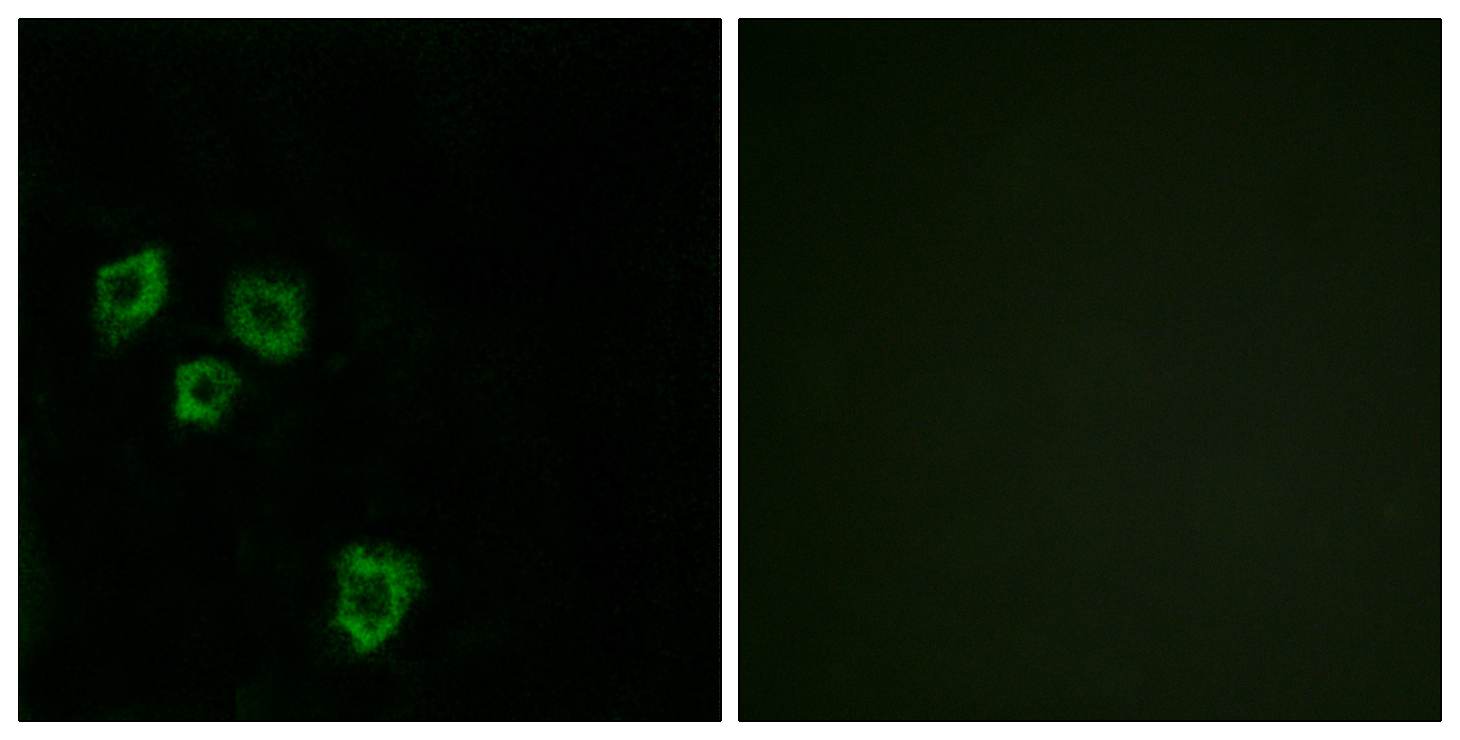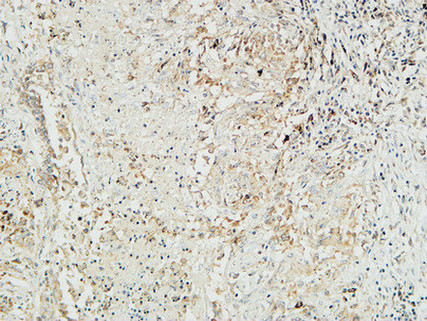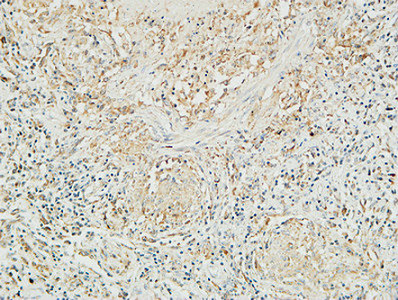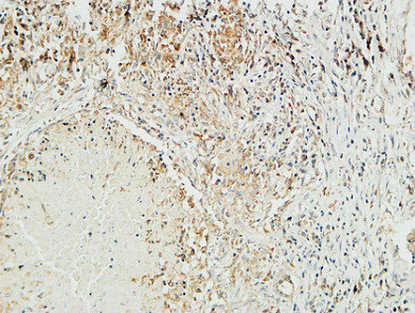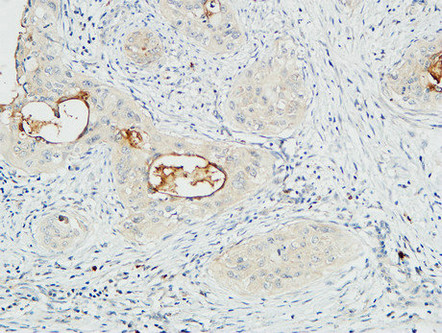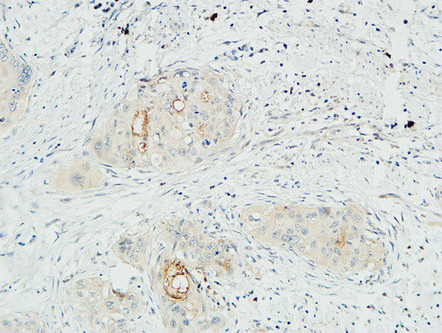产品名称
Mucin 16 Rabbit Polyclonal Antibody
别名
MUC16; CA125; Mucin-16; MUC-16; Ovarian cancer-related tumor marker CA125; CA-125; Ovarian carcinoma antigen CA125
存储缓冲液
Liquid in PBS containing 50% glycerol, 0.5% BSA and 0.02% New type preservative N.
Human Gene Link
http://www.ncbi.nlm.nih.gov/sites/entrez?db=gene&term=94025
Human Swissprot No.
Q8WXI7
Human Swissprot Link
http://www.uniprot.org/uniprotkb/Q8WXI7/entry
免疫原
The antiserum was produced against synthesized peptide derived from human MUC16. AA range:13311-13360
特异性
Mucin 16 Polyclonal Antibody detects endogenous levels of Mucin 16 protein.
稀释度
WB 1:500-2000;IHC-p 1:50-300
宿主
Polyclonal, Rabbit,IgG
背景介绍
domain:Composed of three domains, a Ser-, Thr-rich N-terminal domain, a repeated domain containing more than 60 partially conserved tandem repeats of 156 amino acids each (AAs 12061-21862) and a C-terminal transmembrane contain domain with a short cytoplasmic tail.,function:Thought to provide a protective, lubricating barrier against particles and infectious agents at mucosal surfaces.,induction:Up-regulated in ovarian cancer cells.,miscellaneous:Antigen that is the basis for a widely used serum assay for the monitoring of patients with ovarian epithelial cancer. Due to lack of sensitivity for stage I disease and lack of specificity, it is of little value in the detection of early ovarian cancer. Due to its similarly elevated levels in some nonmalignant conditions, it is not specific enough to be used for population screening.,polymorphism:The number of repeats is highly polymorphic.,PTM:Heavily N-glycosylated; expresses primarily high mannose and complex bisecting type N-linked glycans.,PTM:Heavily O-glycosylated; expresses both type 1 and type 2 core glycans.,PTM:May be phosphorylated. Phosphorylation of the intracellular C-terminal domain may induce proteolytic cleavage and the liberation of the extracellular domain into the extracellular space.,PTM:May contain numerous disulfide bridges. Association of several molecules of the secreted form may occur through interchain disulfide bridges providing an extraordinarily large gel-like matrix in the extracellular space or in the lumen of secretory ducts.,similarity:Contains 14 LRR (leucine-rich) repeats.,similarity:Contains 2 ANK repeats.,similarity:Contains 56 SEA domains.,subcellular location:May be liberated into the extracellular space following the phosphorylation of the intracellular C-terminus which induces the proteolytic cleavage and liberation of the extracellular domain.,subunit:Binds to MSLN. Binding to MSLN mediates heterotypic cell adhesion. This may contribute to the metastasis of ovarian cancer to the peritoneum by initiating cell attachment to the mesothelial epithelium via binding to MSLN.,tissue specificity:Expressed in corneal and conjunctival epithelia (at protein level). Overexpressed in ovarian carcinomas and ovarian low malignant potential (LMP) tumors as compared to the expression in normal ovarian tissue and ovarian adenomas.,
组织表达
Expressed in corneal and conjunctival epithelia (at protein level). Overexpressed in ovarian carcinomas and ovarian low malignant potential (LMP) tumors as compared to the expression in normal ovarian tissue and ovarian adenomas.
细胞定位
Cell membrane; Single-pass type I membrane protein. Secreted, extracellular space. May be liberated into the extracellular space following the phosphorylation of the intracellular C-terminus which induces the proteolytic cleavage and liberation of the extracellular domain.
功能
domain:Composed of three domains, a Ser-, Thr-rich N-terminal domain, a repeated domain containing more than 60 partially conserved tandem repeats of 156 amino acids each (AAs 12061-21862) and a C-terminal transmembrane contain domain with a short cytoplasmic tail.,function:Thought to provide a protective, lubricating barrier against particles and infectious agents at mucosal surfaces.,induction:Up-regulated in ovarian cancer cells.,miscellaneous:Antigen that is the basis for a widely used serum assay for the monitoring of patients with ovarian epithelial cancer. Due to lack of sensitivity for stage I disease and lack of specificity, it is of little value in the detection of early ovarian cancer. Due to its similarly elevated levels in some nonmalignant conditions, it is not specific enough to be used for population screening.,polymorphism:The number of repeats is highly polymorphic.,PTM:Heavily N-glycosylated; expresses primarily high mannose and complex bisecting type N-linked glycans.,PTM:Heavily O-glycosylated; expresses both type 1 and type 2 core glycans.,PTM:May be phosphorylated. Phosphorylation of the intracellular C-terminal domain may induce proteolytic cleavage and the liberation of the extracellular domain into the extracellular space.,PTM:May contain numerous disulfide bridges. Association of several molecules of the secreted form may occur through interchain disulfide bridges providing an extraordinarily large gel-like matrix in the extracellular space or in the lumen of secretory ducts.,similarity:Contains 14 LRR (leucine-rich) repeats.,similarity:Contains 2 ANK repeats.,similarity:Contains 56 SEA domains.,subcellular location:May be liberated into the extracellular space following the phosphorylation of the intracellular C-terminus which induces the proteolytic cleavage and liberation of the extracellular domain.,subunit:Binds to MSLN. Binding to MSLN mediates heterotypic cell adhesion. This may contribute to the metastasis of ovarian cancer to the peritoneum by initiating cell attachment to the mesothelial epithelium via binding to MSLN.,tissue specificity:Expressed in corneal and conjunctival epithelia (at protein level). Overexpressed in ovarian carcinomas and ovarian low malignant potential (LMP) tumors as compared to the expression in normal ovarian tissue and ovarian adenomas.,
纯化
The antibody was affinity-purified from rabbit antiserum by affinity-chromatography using epitope-specific immunogen.
